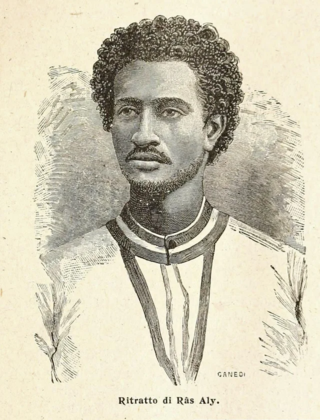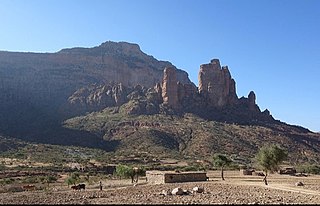
The Tigray Region is the northernmost regional state in Ethiopia. The Tigray Region is the homeland of the Tigrayan, Irob and Kunama people. Its capital and largest city is Mekelle. Tigray is the fifth-largest by area, the fourth-most populous, and the fifth-most densely populated of the 11 regional states.

Gondar, also spelled Gonder, is a city and woreda in Ethiopia. Located in the North Gondar Zone of the Amhara Region, Gondar is north of Lake Tana on the Lesser Angereb River and southwest of the Simien Mountains. As of 2021, Gondar has an estimated population of 443,156.

Weldiya or Woldia is a town, woreda, and capital of the North Wollo Zone in the Amhara Region in northern Ethiopia. It has an elevation of 2112 meters above sea level and is surrounded by Guba Lafto woreda. Both are located north of Dessie and southeast of Lalibela.

The Amhara Region, officially the Amhara National Regional State, is a regional state in northern Ethiopia and the homeland of the Amhara, Awi, Xamir, Argoba, and Qemant people. Its capital is Bahir Dar which is the seat of the Regional Government of Amhara. Amhara is the site of the largest inland body of water in Ethiopia, Lake Tana, and Semien Mountains National Park. Amhara is bordered by Sudan to the west and northwest and by other the regions of Ethiopia: Tigray to the north, Afar to the east, Benishangul-Gumuz to the west and southwest, and Oromia to the south. Towns and cities in Amhara include: Bahir Dar, Dessie, Gonder, Debre Birhan, Debre Tabor, Kombolcha, Weldiya, Debre Markos, Seqota, Kobo, and Metema.

Debre Tabor is a town and woreda in northern Ethiopia. Located in the Debub Gondar Zone of the Amhara Region, about 100 kilometers southeast of Gondar and 50 kilometers east of Lake Tana, this historic town has a latitude and longitude of 11°51′N38°1′E with an elevation of 2,706 metres (8,878 ft) above sea level. The presence of at least 48 springs in the area contributed to the development of Debre Tabor.

Debre Dammo ,The monastery is known as Däbrä Dammo in Tigrinya, and as Däbrä Damo in later Amharic appellations. also spelled Debre Damo, Dabra Dāmmo or Däbrä Dammo), is the name of a flat-topped mountain, or amba, and a 6th-century monastery in Tigray Region of Ethiopia. The mountain is a steeply rising plateau of trapezoidal shape, about 1,000 by 400 m in dimension. It sits at an elevation of 2,216 m (7,270 ft) above sea level. It is north of Bizet and northwest of Adigrat in Central Zone, Tigray, close to the border with Eritrea.
Marye of Yejju was a Ras of Begemder and Enderase (regent) of the Emperor of Ethiopia. He was the brother of his predecessor Ras Yimam.
Dori of Yejju was a Ras of Begemder and Inderase (regent) of the Emperor of Ethiopia. He was the brother of his predecessor Marye of Yejju.

Ali II of Yejju was Ras of Begemder and the de facto ruler of the Ethiopian Empire. He was a member of a powerful Welo dynasty known as the Yejju, which ruled much of the Ethiopian Empire during the Zemene Mesafint.

Buhe is a feast day observed by the Ethiopian Orthodox Tewahedo Church and Eritrean Orthodox Tewahedo Church on 19 August. On this date, the Ethiopian Orthodox Church celebrates the Transfiguration of Jesus on Mount Tabor.
The Battle of Debre Tabor was a conflict during the Zemene Mesafint in 1842 initiated by Dejazmach Wube Haile Maryam to overthrow Ras Ali II as Regent of the Emperor of Ethiopia and gain control of Ethiopia. This confused battle was won by Ras Ali, but at a steep price, and this victory failed to cement his position as the most powerful nobleman of his time.
Debre Zebit is a village in northern Ethiopia. Located in the Semien Wollo Zone of the Amhara Region, about 240 kilometres north of Addis Ababa, this village has a latitude and longitude of 11°49′N38°35′E and an elevation of 2928 meters above sea level. The Central Statistical Agency has not published an estimate for this village's 2005 population. It is one of three towns in Meket woreda.
Nefas Mewcha is a town in northern Ethiopia. Located in the Debub Gondar Zone of the Amhara Region, this town has a latitude and longitude of 11°44′N38°28′E and an elevation of 3150 meters above sea level. It is the administrative center of Lay Gayint woreda.
Dejazmach Birru Aligaz was a nobleman of 19th century Ethiopia during the Zemene Mesafint. As Dejazmach, he held the governorships of different districts such as Lasta and Dembiya and was made governor of Dawunt, Wollo in 1842 by Ras Ali II of Yejju. He was the son of Ras Aligaz Abba Seru Gwangul, and had a son called Dejazmach Zegeye.
Ras Woldemichael Solomon served as the Ras (Duke) of Hamasien during the 19th century. Raesi Woldemichael was born in Hazega village in Hamassien. He is the eldest son of Abeto Solomon Zerai of Hazega and Woizero Eleni. He was the last hereditary ruler to be in power in Mereb Melash.

The Awash–Weldiya Railway is a standard gauge railway under construction, that will serve as a northward extension of the new Ethiopian National Railway Network.

Fano is an ethno-nationalist Amhara militia and former protest movement. It has engaged in violent clashes throughout Ethiopia in the name of neutralizing perceived threats to the Amhara people. Fano has absorbed many units and personnel of the Amhara Regional Special Forces that did not integrate into the Ethiopian National Defense Force (ENDF). Fano militias have been involved in armed conflicts with the Tigray People's Liberation Front (TPLF), the Oromo Liberation Army (OLA), and the ENDF. They have also clashed with the Sudanese Armed Forces (SAF) on the border of Ethiopia and Sudan.

The Guh massacre was a mass extrajudicial killing that took place in Guh in the Tigray Region of Ethiopia during the Tigray War, on 8 May 2021. Guh is a village that belongs to tabiya Debre Selam, woreda Hawzen, Eastern zone of Tigray. It is a small rural settlement on steep slopes below the fifth-century rock-hewn church of Abuna Yemata.

The ENDF National Unity Offensive was a military offensive in the Tigray War launched by the Ethiopian military (ENDF) and pro-government forces to recapture territory in the Amhara and Afar regions being occupied by the Tigray Defense Forces (TDF). Gendarmerie regional forces and local militias from Afar and Amhara had mobilized thousands of fighters and joined the offensive. The ENDF and its allies were able to push TDF forces back from Debre Sina, Amhara to Alamata, Tigray (≈400 km). The Ethiopian government announced the campaign for national unity was a success and had been completed on 23 December 2021.
This is timeline of Mekelle, a city and capital of Tigray Region, Ethiopia.












